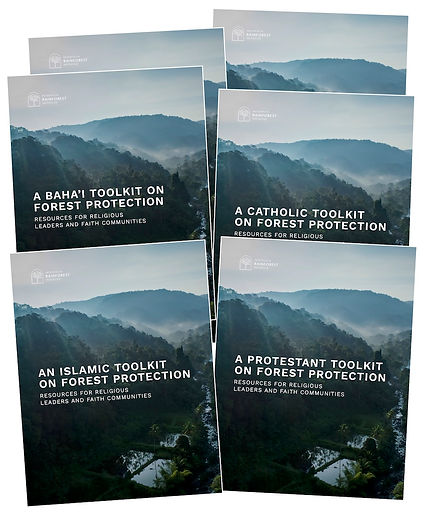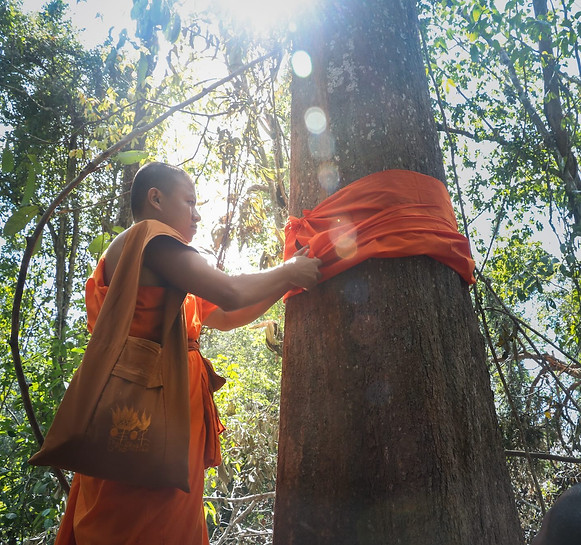
FOREST PROTECTION
© Adriano Gambarini / WWF-Brazil
OVERVIEW
Faiths around the world are actively protecting forests from illegal logging, land clearing for plantations, mining and infrastructure development, from unsustainable natural resource collection and from poaching of threatened wildlife.
Faith actors bring their own cultural and spiritual practices to forest protection, such as the Buddhist monks who patrol the forests of Cambodia and ‘ordain’ trees as monks; the Christian churches conserving northern Ethiopia’s last remaining forest fragments; or the practices of faith communities around the world to safeguard and honour sacred groves, such as the Kaya coastal forests of Kenya, and the estimated 100,000+ sacred groves in India.
In the Vedas, saints and holy people are compared to trees, which give charity to everyone. Trees never complain, but freely give fruit, shade from the sun, shelter from the storm and even their own bodies for fuel.
– Creation: A Story from Ancient India, retold by Rasamandala Das
ADVOCACY
Uniting people of all faiths to end tropical deforestation
The Interfaith Rainforest Initiative is an international, multi-faith alliance that works to bring moral urgency and faith-based leadership to global efforts to end tropical deforestation.
Launched in 2017, it provides a platform for religious leaders to work hand-in-hand with indigenous peoples, governments, civil society organisations and businesses on actions that protect rainforests and safeguard the indigenous peoples that serve as their guardians.
In this way it brings the commitment, influence and moral authority of religions to efforts to protect the world’s rainforests and the indigenous peoples that serve as their guardians.
It has produced a series of toolkits on forest protection to inform and inspire faith communities to take action on forests. They include toolkits for Baha'i, Buddhism, Catholic, Evangelical, Hindu, Islam, Jewish and Protestant communities. All have versions in English, Portuguese and Spanish, and some have French.
Click below to download the toolkits, or to learn more about faiths and advocacy.

BUDDHIST APPROACHES TO FOREST PROTECTION
Buddhist monks and communities are protecting forests, rivers and other habitats in Southeast Asia through on-the-ground patrolling, tree growing, advocacy, education and awareness. These ‘eco-monks’ are seen as warriors for the environment and their efforts to protect the forests and habitat are unique and effective – 'ordaining' trees as monks to deter loggers and hunters.
Click below to visit our dedicated pages, Buddhists & Forests in Southeast Asia and Buddhist Action in Cambodia, to learn more, including how monks are using tree ordination to protect forests.

A Buddhist monk ordains a tree, by Sina, WWF-Cambodia

SACRED GROVES, SACRED FORESTS
The oldest form of habitat protection
When people consider an area sacred, they are deeply motivated to protect it. Sacred groves are areas of a forest or group of trees protected by a community or faith group due to their religious significance.
They are sometimes referred to the oldest form of habitat protection and in some landscapes are the most important areas of biodiversity. They are found all over the world – India is said to have the most but no official inventory has been done.
Learn more about sacred groves and other forms of sacred natural sites by visiting our Sacred Natural Sites page. See also our Sacred Species page.
Sacred grove, by Amir Mortezaie on Unsplash

Be inspired
STORIES FROM THE FIELD

Find partners
Groups working on faith & forest protection
UN Decade on Ecosystem Restoration
Interfaith Rainforest Initiative
WWF’s Beliefs & Values Programme
OIKOdiplomatique: Adding ethical value to advocacy and diplomacy
Please contact us if you are working on faith & forest protection and would like your organisation to be listed here.
Get started
Key guidance documents
Interested in getting a collaboration or a project going with a faith community but not sure where to start? Check out these key guidance documents.















